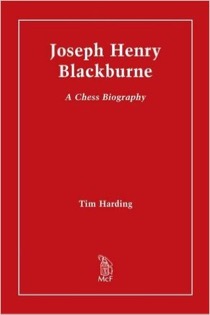Joseph Henry Blackburne
A Chess Biography
Tim Harding

Tim Hardings latest book, Joseph Henry Blackburne: A Chess Biography, is a massive oversized work (8.5 x 11) of 592 pages. Even more impressive than its size and weight is the amount of effort that went into producing this book on the greatest practical player Britain produced until the last quarter of the twentieth century.
Most chess players will remember Blackburne, nicknamed The Black Death, as a colorful character and indeed there are many stories about him. One famous anecdote involving Blackburne had him drinking his opponents glass of whiskey during a simul and then uttering, He left it en prise and I took it en passant. Harding takes a critical look at such stories and shows there is much, much more to this player who was among the worlds top ten for several decades and was for a period of time among the top three.
Blackburne was an active player for over 60 years and during this time P. Anderson Graham, who edited Mr. Blackburne’s Games at Chess, estimated he played between 50,000 and 100,000 games, the majority of them in casual play be it one on one or in the many simultaneous exhibitions he gave throughout his life. The latter were Blackburnes bread and butter and allowed him to support himself as a chess professional at a time when the concept was scarcely known. Also paying the bills was Blackburnes expertise at blindfold chess, a field in which he was also among the best in the 19th century. It was a visit by Louis Paulsen to Blackburnes hometown of Manchester in 1861, during which the latter lost a blindfold game to the famous German master, which spurred his interest in playing sans voir.
Authors writing about contemporary players dont have to deal with the sort of challenges that Harding was forced to address when writing this book. Most events Blackburne played in did not have bulletins or tournament books dedicated to them and often times the scores of drawn games might be thrown out when they lead to a replay and the result didnt count. Games published in newspapers and magazines were often truncated. Adding to the challenge Blackburnes line appears to have died out leaving no possible windfall of lost games miraculously appearing. Taking all of this into account Hardings collecting 1,186 of his games is a significant accomplishment.
Joseph Henry Blackburne: A Chess Biography is more than a large collection of Blackburnes games (many with annotations). Working pretty much from scratch Harding has gathered a considerable amount of biographical information which he has put into its historical context. While this is a work on Blackburne inevitably a great deal of attention is focused on his contemporaries, both world class players like Steinitz and Zukertort, but also many well-known English amateurs. This book features many photographs, drawings, illustrations and caricatures that help put a face to many well-known names of the past like Winawer, Kolisch, Lowenthal and others.
Harding also offers the reader close to 60 of Blackburnes chess compositions, interviews the great master gave and many detailed indices. Like all McFarland books the production qualities are first rate with good quality paper and library binding.
Anyone with an interest in Blackburne or chess in the second half of the 19th century and early 20th century will love this book.
Highly recommended.
